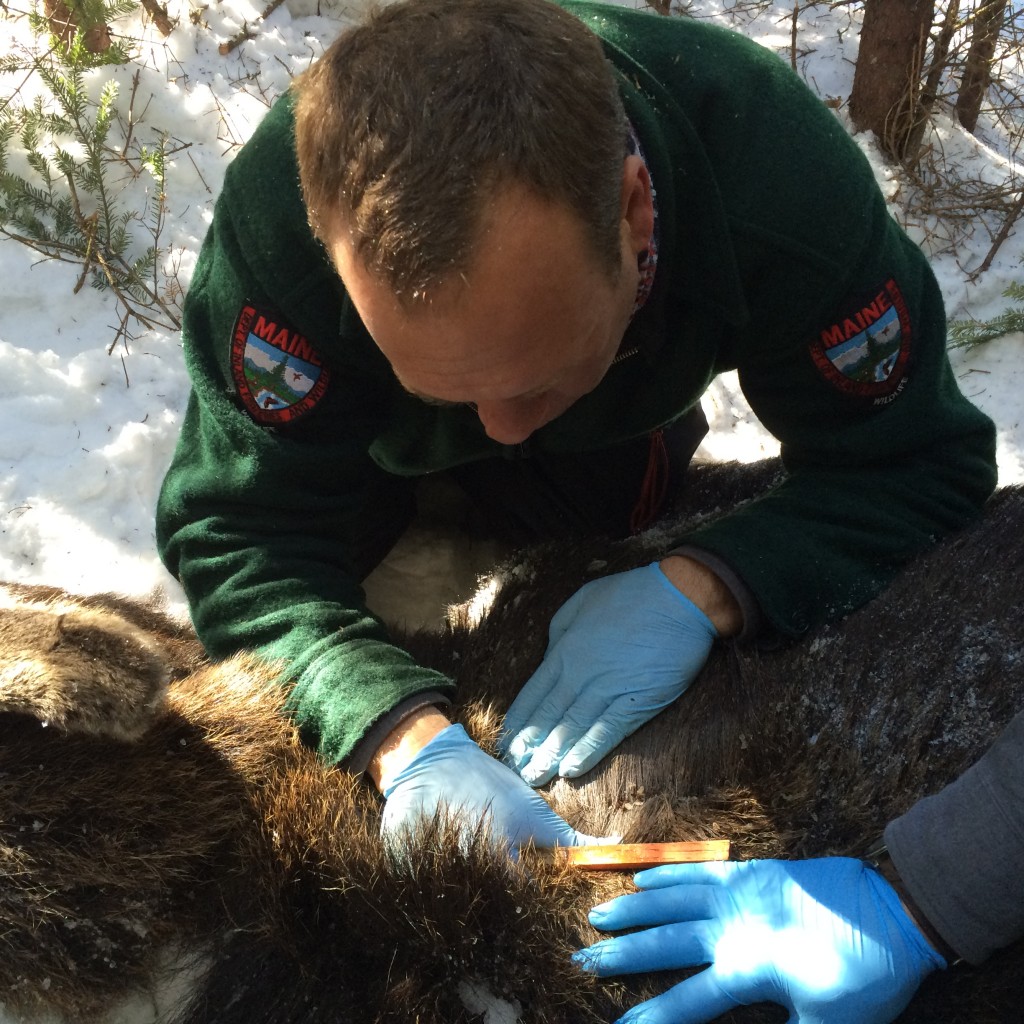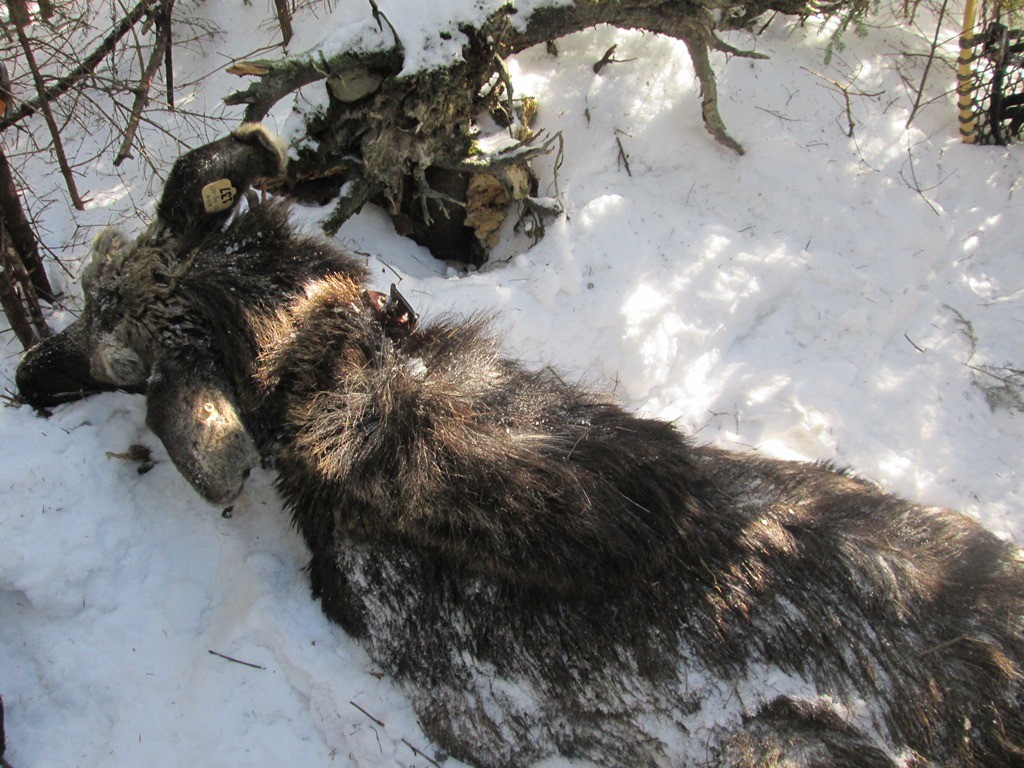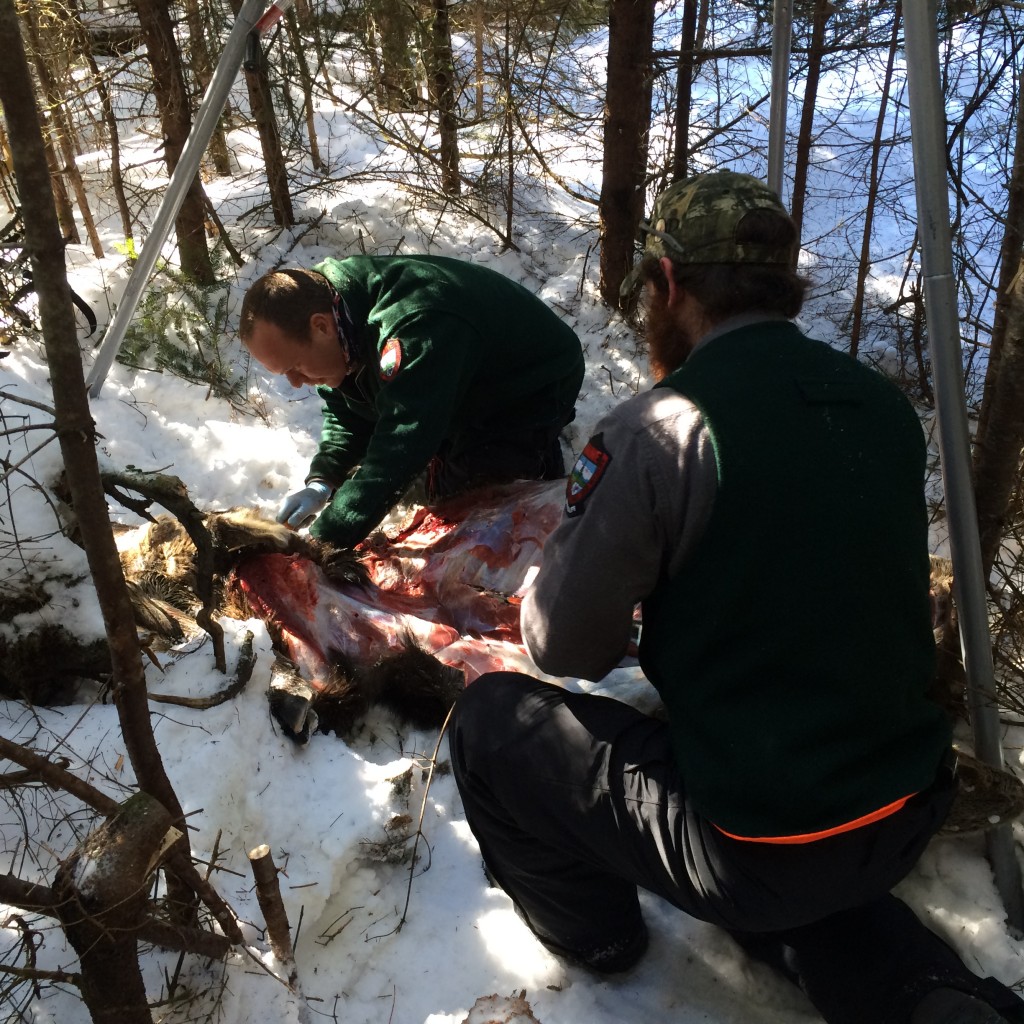March 17, 2016 at 3:58 pm
By Scott McClellan, IFW Wildlife Biologist
[caption id="attachment_1316" align="alignright" width="572"] Biologist Scott McLellan counts ticks during a moose necropsy. The tick counts provide insight into factors that impact Maine's moose population.[/caption]
In 2014, the Maine Department of Inland Fisheries and Wildlife (IFW) initiated a moose survival study in Wildlife Management District 8 that involves the capture, radio-collaring, and subsequent tracking of these study animals to learn more about their behavior, reproduction, landscape use, and survivability. The moose study was expanded to include WMD 2 this year, and now includes nearly 150 radio-collared moose.
Maine has more moose than any other state in the continental US. In order to manage moose in Maine, it is important to understand how many moose there are in the state, how many moose are being born into the population, and how many moose are dying every year. In addition, it is important to know what is causing the moose to die and whether there is anything that can be done about it.
We have learned that March and April are the critical months for the survivability of moose. These are the months when the majority of moose die, especially young-of-the-year calves (that are about 10-11 months of age during these 2 months) that were born the previous year. IFW has recently investigated several calf mortalities where biologists collected biological data that includes external examination of animal, tick counts, organ sampling, and fecal collection.
[caption id="attachment_1317" align="alignleft" width="462"]
Biologist Scott McLellan counts ticks during a moose necropsy. The tick counts provide insight into factors that impact Maine's moose population.[/caption]
In 2014, the Maine Department of Inland Fisheries and Wildlife (IFW) initiated a moose survival study in Wildlife Management District 8 that involves the capture, radio-collaring, and subsequent tracking of these study animals to learn more about their behavior, reproduction, landscape use, and survivability. The moose study was expanded to include WMD 2 this year, and now includes nearly 150 radio-collared moose.
Maine has more moose than any other state in the continental US. In order to manage moose in Maine, it is important to understand how many moose there are in the state, how many moose are being born into the population, and how many moose are dying every year. In addition, it is important to know what is causing the moose to die and whether there is anything that can be done about it.
We have learned that March and April are the critical months for the survivability of moose. These are the months when the majority of moose die, especially young-of-the-year calves (that are about 10-11 months of age during these 2 months) that were born the previous year. IFW has recently investigated several calf mortalities where biologists collected biological data that includes external examination of animal, tick counts, organ sampling, and fecal collection.
[caption id="attachment_1317" align="alignleft" width="462"] This radio-collared moose didn't survive the winter. A field necropsy of the moose provides clues as to why this moose didn't survive.[/caption]
Once the data and samples are collected, they are transported to the diagnostic laboratory at the University of Maine for further analysis. All of this work requires a dedicated team of people to ensure that all of the data, from start to finish, is collected in a scientific, meaningful manner. The accompanying pictures illustrate biologists collecting information at a recent necropsy.
This is year three of the five year study. The first two years of the study were during severe winters, which are in contrast to this year’s comparatively mild winter. Over the next few years, analyzing and understanding the biological data will be instrumental in managing Maine’s moose population into the future.
[caption id="attachment_1315" align="alignright" width="502"]
This radio-collared moose didn't survive the winter. A field necropsy of the moose provides clues as to why this moose didn't survive.[/caption]
Once the data and samples are collected, they are transported to the diagnostic laboratory at the University of Maine for further analysis. All of this work requires a dedicated team of people to ensure that all of the data, from start to finish, is collected in a scientific, meaningful manner. The accompanying pictures illustrate biologists collecting information at a recent necropsy.
This is year three of the five year study. The first two years of the study were during severe winters, which are in contrast to this year’s comparatively mild winter. Over the next few years, analyzing and understanding the biological data will be instrumental in managing Maine’s moose population into the future.
[caption id="attachment_1315" align="alignright" width="502"] Biologists collect samples from different internal organs that are later examined at the UMaine Research Lab.[/caption]
Biologists collect samples from different internal organs that are later examined at the UMaine Research Lab.[/caption]
 Biologist Scott McLellan counts ticks during a moose necropsy. The tick counts provide insight into factors that impact Maine's moose population.[/caption]
In 2014, the Maine Department of Inland Fisheries and Wildlife (IFW) initiated a moose survival study in Wildlife Management District 8 that involves the capture, radio-collaring, and subsequent tracking of these study animals to learn more about their behavior, reproduction, landscape use, and survivability. The moose study was expanded to include WMD 2 this year, and now includes nearly 150 radio-collared moose.
Maine has more moose than any other state in the continental US. In order to manage moose in Maine, it is important to understand how many moose there are in the state, how many moose are being born into the population, and how many moose are dying every year. In addition, it is important to know what is causing the moose to die and whether there is anything that can be done about it.
We have learned that March and April are the critical months for the survivability of moose. These are the months when the majority of moose die, especially young-of-the-year calves (that are about 10-11 months of age during these 2 months) that were born the previous year. IFW has recently investigated several calf mortalities where biologists collected biological data that includes external examination of animal, tick counts, organ sampling, and fecal collection.
[caption id="attachment_1317" align="alignleft" width="462"]
Biologist Scott McLellan counts ticks during a moose necropsy. The tick counts provide insight into factors that impact Maine's moose population.[/caption]
In 2014, the Maine Department of Inland Fisheries and Wildlife (IFW) initiated a moose survival study in Wildlife Management District 8 that involves the capture, radio-collaring, and subsequent tracking of these study animals to learn more about their behavior, reproduction, landscape use, and survivability. The moose study was expanded to include WMD 2 this year, and now includes nearly 150 radio-collared moose.
Maine has more moose than any other state in the continental US. In order to manage moose in Maine, it is important to understand how many moose there are in the state, how many moose are being born into the population, and how many moose are dying every year. In addition, it is important to know what is causing the moose to die and whether there is anything that can be done about it.
We have learned that March and April are the critical months for the survivability of moose. These are the months when the majority of moose die, especially young-of-the-year calves (that are about 10-11 months of age during these 2 months) that were born the previous year. IFW has recently investigated several calf mortalities where biologists collected biological data that includes external examination of animal, tick counts, organ sampling, and fecal collection.
[caption id="attachment_1317" align="alignleft" width="462"] This radio-collared moose didn't survive the winter. A field necropsy of the moose provides clues as to why this moose didn't survive.[/caption]
Once the data and samples are collected, they are transported to the diagnostic laboratory at the University of Maine for further analysis. All of this work requires a dedicated team of people to ensure that all of the data, from start to finish, is collected in a scientific, meaningful manner. The accompanying pictures illustrate biologists collecting information at a recent necropsy.
This is year three of the five year study. The first two years of the study were during severe winters, which are in contrast to this year’s comparatively mild winter. Over the next few years, analyzing and understanding the biological data will be instrumental in managing Maine’s moose population into the future.
[caption id="attachment_1315" align="alignright" width="502"]
This radio-collared moose didn't survive the winter. A field necropsy of the moose provides clues as to why this moose didn't survive.[/caption]
Once the data and samples are collected, they are transported to the diagnostic laboratory at the University of Maine for further analysis. All of this work requires a dedicated team of people to ensure that all of the data, from start to finish, is collected in a scientific, meaningful manner. The accompanying pictures illustrate biologists collecting information at a recent necropsy.
This is year three of the five year study. The first two years of the study were during severe winters, which are in contrast to this year’s comparatively mild winter. Over the next few years, analyzing and understanding the biological data will be instrumental in managing Maine’s moose population into the future.
[caption id="attachment_1315" align="alignright" width="502"] Biologists collect samples from different internal organs that are later examined at the UMaine Research Lab.[/caption]
Biologists collect samples from different internal organs that are later examined at the UMaine Research Lab.[/caption]Categories